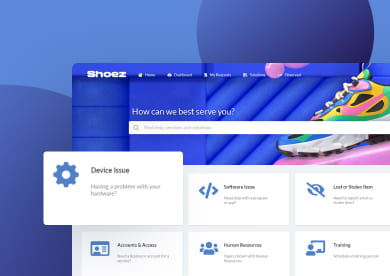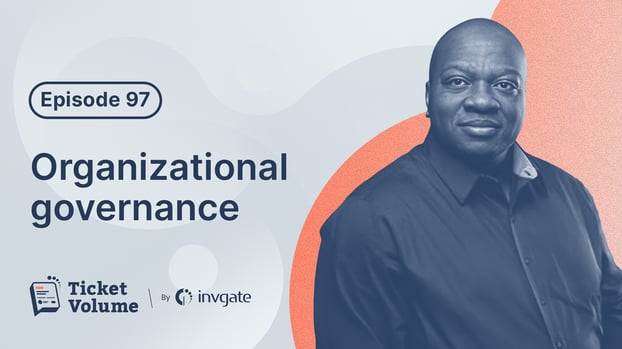Governance is a term thrown around often in IT and business discussions, but do we really understand what it means? In Episode 97 of Ticket Volume - IT Podcast, host Matt Beran sat down with Valence Howden, an advisory fellow at InfoTech Research Group, to unpack governance, its misconceptions, and its true role in enabling organizations to succeed.
This conversation dives deep into organizational governance as more than just a set of rules or compliance measures. Instead, it’s the foundation of organizational success, defining purpose, accountability, and alignment. If governance has ever felt like a roadblock rather than an enabler in your organization, this discussion is for you.

What is governance, really?
When most people hear the word governance, they think of bureaucracy, rigid policies, and endless approvals. But as Valence explains, governance is actually the lifeblood of an organization—it starts with defining the company’s purpose, what value looks like, and how to align decisions and behaviors to achieve that value.
Governance should be seen as an enabler, not just a control mechanism. It ensures that decisions support the organization’s mission while also providing a framework for accountability and authority—who gets to make decisions and who is responsible for outcomes.
However, many organizations get caught up in the weeds, making governance too rigid or too reactionary—losing sight of its real intent. Valance stresses that governance should be adaptable and dynamic, not just a rulebook set in stone.
Healthy vs. unhealthy governance
How can we differentiate between effective governance and governance gone wrong?
In a healthy organization, governance aligns organizational goals with daily operations, enables decision-making rather than acting as a constraint, provides accountability without unnecessary bureaucracy, and evolves with the company’s needs and industry changes.
“If you want to change governance and it’s not working, look at who benefits from the method. If they’re too powerful, you’re not going to move it.”
Valance Howden, Advisory Fellow at Info-Tech Research Group
On the other hand, unhealthy governance is often overly rigid, implemented as a reaction to past failures rather than strategic thinking. It can also be used as a tool to hoard authority rather than distribute it effectively. Worse yet, some organizations resist change simply because they are too accustomed to outdated governance models.
Governance and organizational change
For IT teams, governance is often the invisible hand that either enables change or hinders it.
One key takeaway from this conversation is the difference between buy-in and commitment. Many organizations claim to support change but fail to adjust governance structures to align with new objectives. True commitment means making governing decisions that support the change, allocating resources to enable transformation, and changing performance measurements to align with new goals.
Without these adjustments, governance becomes a bottleneck rather than a support system. Agile teams, DevOps, and digital transformation initiatives all require governance that adapts and enables faster, more informed decision-making.
Governance in IT: Beyond the stereotypes
Governance is often unfairly associated with slow, bureaucratic IT processes, especially in areas like Change Management. But governance isn’t about slowing things down—it’s about ensuring that change happens safely, effectively, and with the right oversight.
“Uninformed governance is a dangerous thing. You can only make decisions with the information that’s at hand.”
Valance Howden, Advisory Fellow at Info-Tech Research Group
Some key IT governance insights from Valance include the role of governance in risk and security, highlighting how IT teams often take the blame for security failures even when governance structures prevented them from acting.
Another crucial factor is the challenge of siloed operations, where governance should prevent silos but often fails to align across departments. Finally, governance needs to balance empowerment and responsibility, ensuring teams have both the authority and context to make informed decisions.
Fixing governance: Making it work for your organization
If governance is broken in your organization, what can you do? Here are some useful tips to improve governance:
- Build governance into systems and processes rather than enforcing it through committees. Integrating governance into automation, policies, and workflows makes it a natural part of daily operations.
- Reevaluate outdated governance structures to ensure they evolve alongside your organization’s growth and changing needs.
- Understand cultural differences in governance styles, especially in multinational organizations, to avoid imposing a one-size-fits-all model that doesn’t work across diverse teams.
- Encourage accountability with authority by ensuring that teams have both the right information and decision-making power, rather than simply holding them responsible for failures.
Governance should not be a series of hurdles—it should help organizations move faster while staying aligned with goals.
Final thoughts
Governance is often misunderstood and misapplied, but as Valence points out, it’s one of the most important factors in organizational success. The key takeaways from this conversation are that governance is not about control—it’s about alignment and accountability. Poor governance structures lead to power struggles, inefficiencies, and resistance to change, whereas good governance enables faster decision-making, risk management, and organizational success.
Instead of viewing governance as a necessary evil, IT leaders should start treating it as a strategic advantage—a way to empower teams, protect organizations, and drive meaningful change.
Want to learn more?
This is just a glimpse into the full discussion between Matt and Valence on Ticket Volume – IT Podcast. If you’re interested in hearing the full conversation, check out the episode and join the discussion on governance.
You can find the full episode on Apple Podcasts, Spotify, YouTube, or your favorite podcast platform.















